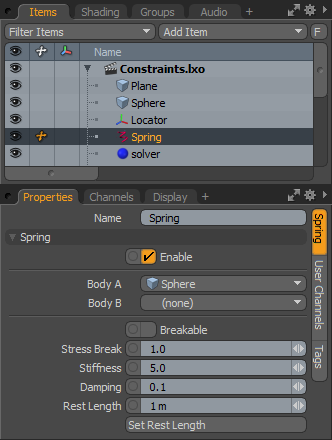Spring

The spring is a special constraint that mimics the motion of an actual coiled spring. The spring constraint produces a motion similar to the point constraint, swinging and swaying, with the addition of the stretching and compression action of a spring. It is represented in the viewport by a coil that extends and compresses as objects move during a simulation.
To apply a slide hinge constraint automatically, follow these steps:
| 1. | Select two items prior to invoking any of the constraint types. |
The first item selected represents the master or parent item and is defined as Body A in the constraint, the second item selected is the item that is constrained, also considered the auxiliary or child item, defined as Body B.
| 2. | With the items selected, in the Dynamics sub-tab, click on the Spring constraint button. |
This adds the constraint item to the Items list.
By default, the spring stretches between the center points of the two selected objects.
Note: While constraints can be added manually to a scene by way of the Items list, automatically assigning them to items is the preferred method as it also automatically defines the constraint's position relative to the selected items.

|
Option |
Description |
|---|---|
|
Name |
Displays the current constraint item name. To change it, click on the field and type in the new name. |
|
Spring |
|
|
Enable |
Toggles the spring item on or off. When enabled, the spring is considered during a dynamics simulation; when disabled, the spring is ignored. However, disabled items are persistent across Modo sessions, being saved with the scene, and retain their present settings. |
|
SubCollisions |
When enabled, allows constrained objects (especially those within a chain, not a literal chain, but subsequent groupings) to collide with one another. When disabled (the default state), fewer calculations are required, however, constrained items may inter-penetrate each other. If this occurs, enable SubCollisions. |
|
Body A |
Represents the item that another item is constrained to, the parent or master item. |
|
Body B |
Represents the item that is constrained, the child or auxiliary item. |
|
Breakable |
Allows the spring to be broken apart when a certain stress threshold is reached, defined by the Break Stress value. When the threshold is reached, the spring no longer has any effect on the constrained item, leaving it to be affected by any other forces present in the simulation. |
|
Stress Break |
Determines the threshold when the spring no longer affects the constrained item. The Breakable option must be enabled for this value to have any effect on the spring. |
|
Stiffness |
The amount of force it takes to compress the spring. A stiffer spring is harder to compress. |
|
Damping |
During a simulation, a spring oscillates between extended and compressed. The Damping effect reduces the amplitude of the spring's oscillations over time. |
|
Rest Length |
Represents the length of the spring when it is not in motion. This can also be considered the distance between the two constraining items when the spring reaches equilibrium. |
